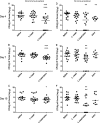Immunization of mice with Lactobacillus casei expressing a beta-intimin fragment reduces intestinal colonization by Citrobacter rodentium
- PMID: 21900533
- PMCID: PMC3209022
- DOI: 10.1128/CVI.05262-11
Immunization of mice with Lactobacillus casei expressing a beta-intimin fragment reduces intestinal colonization by Citrobacter rodentium
Abstract
Enteropathogenic Escherichia coli (EPEC) is a common cause of diarrhea in children from developing countries. Intimate adhesion of the bacteria to intestinal cells occurs via binding of the adhesin intimin to the TIR receptor exposed on cell surfaces. Here, Lactobacillus casei expressing a fragment of β-intimin (L. casei-Int(cv)) was tested as mucosal vaccines in mice against intestinal colonization with the murine pathogen Citrobacter rodentium. Oral or sublingual immunization of C57BL/6 mice with L. casei-Int(cv) induced anti-Int(cv) IgA in feces but no IgG in sera. Conversely, anti-Int(cv) IgG was induced in the sera of mice after sublingual immunization with purified Int(cv). All vaccines were able to decrease C. rodentium recovery from feces. However, this reduction was more evident and sustained over time in mice immunized with L. casei-Int(cv) by the sublingual route. These mice also displayed an increase in interleukin 6 (IL-6) and gamma interferon (IFN-γ) secretion by spleen cells 10 days after infection. Additionally, oral or sublingual immunization of C3H/HePas mice, which are highly susceptible to C. rodentium infection, with L. casei-Int(cv) induced anti-Int(cv) antibodies and significantly increased survival after challenge. Immunohistological analysis of colon sections revealed that C. rodentium was located in deep fractions of the tissue from C3H/HePas mice immunized with L. casei whereas superficial staining was observed in colon sections from mice immunized with L. casei-Int(cv.) The results indicate that vaccines composed of L. casei expressing intimin may represent a promising approach and that the C3H/HePas infection model with C. rodentium can be used to evaluate potential vaccines against EPEC.
Figures







Similar articles
-
Immunization with recombinant Lactobacillus casei strains producing K99, K88 fimbrial protein protects mice against enterotoxigenic Escherichia coli.Vaccine. 2012 May 9;30(22):3339-49. doi: 10.1016/j.vaccine.2011.08.036. Epub 2011 Aug 19. Vaccine. 2012. PMID: 21856357
-
Protective effects of oral immunization with formalin-inactivated whole-cell Citrobacter rodentium on Citrobacter rodentium infection in mice.J Microbiol Methods. 2019 Apr;159:62-68. doi: 10.1016/j.mimet.2019.02.016. Epub 2019 Feb 25. J Microbiol Methods. 2019. PMID: 30817947
-
Intimin-specific immune responses prevent bacterial colonization by the attaching-effacing pathogen Citrobacter rodentium.Infect Immun. 2001 Sep;69(9):5597-605. doi: 10.1128/IAI.69.9.5597-5605.2001. Infect Immun. 2001. PMID: 11500434 Free PMC article.
-
Citrobacter rodentium: a model enteropathogen for understanding the interplay of innate and adaptive components of type 3 immunity.Mucosal Immunol. 2017 Sep;10(5):1108-1117. doi: 10.1038/mi.2017.47. Epub 2017 Jun 14. Mucosal Immunol. 2017. PMID: 28612839 Free PMC article. Review.
-
What's for dinner? How Citrobacter rodentium's metabolism helps it thrive in the competitive gut.Curr Opin Microbiol. 2021 Oct;63:76-82. doi: 10.1016/j.mib.2021.06.004. Epub 2021 Jul 6. Curr Opin Microbiol. 2021. PMID: 34243134 Review.
Cited by
-
A Self-Assembling Whole-Cell Vaccine Antigen Presentation Platform.J Bacteriol. 2018 Jul 10;200(15):e00752-17. doi: 10.1128/JB.00752-17. Print 2018 Aug 1. J Bacteriol. 2018. PMID: 29483163 Free PMC article.
-
Peptide-Based Vaccines for Tuberculosis.Front Immunol. 2022 Jan 31;13:830497. doi: 10.3389/fimmu.2022.830497. eCollection 2022. Front Immunol. 2022. PMID: 35173740 Free PMC article. Review.
-
Lactobacillus Mucosal Vaccine Vectors: Immune Responses against Bacterial and Viral Antigens.mSphere. 2018 May 16;3(3):e00061-18. doi: 10.1128/mSphere.00061-18. eCollection 2018 May-Jun. mSphere. 2018. PMID: 29769376 Free PMC article. Review.
-
Prophylactic vaccine delivery systems against epidemic infectious diseases.Adv Drug Deliv Rev. 2021 Sep;176:113867. doi: 10.1016/j.addr.2021.113867. Epub 2021 Jul 17. Adv Drug Deliv Rev. 2021. PMID: 34280513 Free PMC article. Review.
-
TACI deficiency enhances antibody avidity and clearance of an intestinal pathogen.J Clin Invest. 2014 Nov;124(11):4857-66. doi: 10.1172/JCI74428. Epub 2014 Oct 1. J Clin Invest. 2014. PMID: 25271628 Free PMC article.
References
-
- Abe C. M., et al. 2009. Virulence features of atypical enteropathogenic Escherichia coli identified by the eae(+) EAF-negative stx(-) genetic profile. Diagn. Microbiol. Infect. Dis. 64:357–365 - PubMed
-
- Adachi K., et al. 2010. Oral immunization with a Lactobacillus casei vaccine expressing human papillomavirus (HPV) type 16 E7 is an effective strategy to induce mucosal cytotoxic lymphocytes against HPV16 E7. Vaccine 28:2810–2817 - PubMed
-
- Aida Y., Pabst M. J. 1990. Removal of endotoxin from protein solutions by phase separation using Triton X-114. J. Immunol. Methods 132:191–195 - PubMed
Publication types
MeSH terms
Substances
Grants and funding
LinkOut - more resources
Full Text Sources
Other Literature Sources
Miscellaneous

